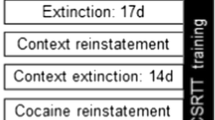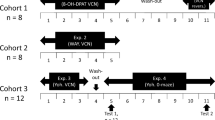Abstract
An impulsive cognitive style may affect behaviour in several different ways, including rapid decision making, intolerance of the delay of reward and a tendency to terminate chains of responses prematurely. It has been proposed to measure the last of these in rats using fixed consecutive number (FCN) schedules. The present study uses a modified version of the FCN procedure in which responding was paced by retracting the response lever for short periods between presses. In this way, the experimenter can control the maximum rate of responding. The procedure was made up of two components. In both, the schedule requirement was FCN 8, but in the Fast component lever presses were spaced by a minimum of 2.5 s and in the Slow component by a minimum of 5 s. Alterations in impulsivity were inferred from changes in the mean chain length and the distribution of chain lengths. The 5-HT1A agonist, 8-OH-DPAT (0.03–0.3 mg/kg), increased chain lengths within a narrow dose range, whereas the 5-HT1A antagonist, WAY 100 635 (0.03–0.3 mg/kg), reduced chain lengths. The 5-HT2 agonist, DOI (0.1–1.0 mg/kg), markedly reduced chain lengths, whereas the 5-HT2 antagonist, ritanserin (0.03–0.3 mg/kg), had no effect. The 5-HT1A/1b agonist, RU 24969 (0.03–0.3 mg/kg), reduced chain lengths. The 5-HT releaser, p-chloramphetamine (0.1–1.0 mg/kg), had a weak, biphasic effect, slightly reducing the number of short chains at the lowest dose tested and slightly increasing this number at the highest dose. Other drugs tested, citalopram (1.0–10.0 mg/kg), metergoline (0.3–3.0 mg/kg) and MDL-72222 (0.1–3.0 mg/kg), had no significant effects. These results suggest that stimulation of 5-HT1A receptors reduces impulsivity, whereas stimulation of 5-HT2 receptors increases it. These data are in agreement with previous results using the DRL-72 schedule, and indicate that there is no simple role for serotonin in the control of impulsivity.
Similar content being viewed by others
Author information
Authors and Affiliations
Additional information
Received: 29 November 1997/Final version: 2 April 1998
Rights and permissions
About this article
Cite this article
Evenden, J. The pharmacology of impulsive behaviour in rats IV: the effects of selective serotonergic agents on a paced fixed consecutive number schedule. Psychopharmacology 140, 319–330 (1998). https://doi.org/10.1007/s002130050773
Issue Date:
DOI: https://doi.org/10.1007/s002130050773




